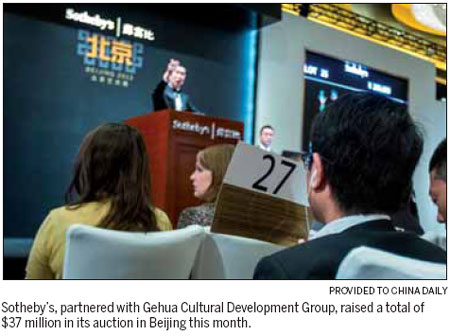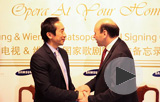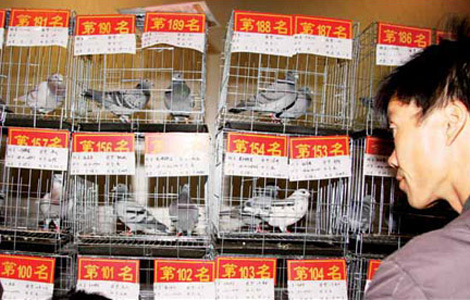In art we trust
By Li Xiang in Paris ( China Daily Europe ) Updated: 2013-12-20 10:00:41
Changing paradigms
Although New York regained its position from Beijing as the leading global city in terms of art sales last year, many experts feel that China will soon replace the US and Europe as the world's art trading center, given the size of its domestic sales and the international significance of its buyers.
The art market has developed into a business worth more than $12 billion in terms of annual sales in China, where it barely existed 20 years ago.
Even though the Chinese art market has had the strongest growth, many experts feel it is still far from being a genuine art-trading center.
"China's art market is being pushed forward little by little. In fact the market is not fully prepared for such a status as far as the consumers, the operators and the government policy are concerned," says Wang from Beijing Gehua Art Co.
Some experts say the sales figures at auction houses fail to reflect the real size of the Chinese art market because of the high non-payment rate. According to research by the European Fine Art Fair, up to 40 percent of the auction proceeds in the Chinese art market were unpaid or only partly paid.
Vellenga, the fair's representative, says: "If you deduct that percentage, the total sales in the art market of the Chinese mainland will not be No 1 as the non-payment rate at European and American auction markets is almost zero. So the US art market is still the strongest one," .
But the vast potential of the Chinese art market and the strong purchasing power of Chinese buyers are undeniable as the market gradually matures and more high-end institutional collectors are entering the market and view art as an effective way to better manage their investment portfolios.
Dalian Wanda Group's recent Picasso purchase was the first time that a Chinese company competed with top-end Western collectors for a sought-after art piece with an unprecedented price.
"More and more Chinese art buyers have begun to realize that the real hard currency in the international art market is the mainstream master pieces of Western art instead of the ancient or contemporary Chinese arts," Wang says.
"So it is a rational investment choice for large institutional collectors to allocate some European arts in their art collections."
It is estimated that there are now only about 30 large collectors of Western art from the Chinese mainland. But experts estimate the number will increase rapidly as the market is accumulating more knowledge, experience and practice in the field.
In addition, the potential of Chinese art buyers also lies in their emerging interest in other art forms including Western arts, experts say.
"The interest from the Chinese mainland now plays a role not only in the market for Asian art categories but across most of our international collections from furniture to silver, books to Victorian art, and old masters to contemporary art," says De Vos, Christie's European head of Chinese Works of Art.
"Asian collectors, including those specifically from the Chinese mainland, have an incredible appetite and intelligence for art and are becoming increasingly sophisticated in their purchases across all categories and at every price level," she says.
"Looking at 2014, with our program of sales in the Chinese mainland and the development in Hong Kong, I am confident that Asia's role as a prominent art center can only rise in the years to come."
In the meantime, European art fairs such as the European Fine Art Fair, have been keen on bringing Western artworks to the Chinese market as the first step to expand Chinese demand.
"We feel there is lot of potential in China as figures show about 90 percent of art trading has taken place in the home market," Vellenga says. "So it makes sense for us to be present there, instead of only focusing on Chinese buyers traveling to Europe and the US."
Meanwhile, the art market in China that is largely dependent on a few top collectors at the top end of the value chain is slowly seeing middle and lower-end branches develop.
"Apart from the purchases at the top end, Chinese buyers have also been active in the entry level market - where sales prices start at approximately 500 euros, often resulting in fierce competition," says De Vos from Christie's.
Patricia Ederhy, president of Les Puces de Saint Ouen, the largest flea market in Paris, says that Chinese purchases accounted for more than 20 percent of the market's total sales revenue of 350 million euros for last year.
"I think in five years the Chinese will surpass the Americans as the biggest clients of our market as they are not only interested in Chinese art but also European art, for example, the French artworks from the Napoleon III period," she says.
To increase sales' accessibility to the Chinese buyers, international auction houses are also competing in online auction sales.
"Accessibility is key," De Vos says. "Our inaugural season of online-only auctions attracted 39 percent new buyers last year. In the first six months of this year, 46 percent of buyers at online-only auctions were new to Christie's."
The auction house conducted two exclusive online sales of Chinese artworks in July, the first exclusive Internet opportunities for collectors, De Vos says.
European Weekly
 China taken on as building partner
China taken on as building partner
Meetings with central and Eastern European heads underline China's global roal.













